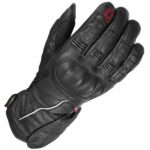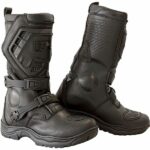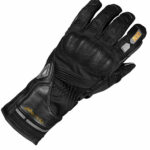The open road calls to many motorcycle enthusiasts, but with the thrill of cruising comes the responsibility of ensuring rider safety. One game-changing technology that has elevated motorcycle safety is the Anti-lock Braking System (ABS). In this blog post, we will explore the ins and outs of “what is ABS in motorcycles”, from understanding its fundamentals to debunking myths and misconceptions surrounding its use. So buckle up and get ready to dive into the world of ABS!
Short Summary
-
- – ABS technology enhances safety and control for motorcyclists, providing shorter stopping distances, increased rider confidence, and improved stability.
- – ABS systems vary in features. Single-channel is lightweight & cost-effective, while Dual-channel offers more precise brake response.
- – Motorcycle ABS provides a variety of benefits, including enhanced safety, lower wear & tear costs and decreased risk of skidding.
Understanding Motorcycle ABS
ABS, or Anti-lock Braking System, is a technology designed to increase the safety of motorcycles and other vehicles by preventing wheel locking and enhancing stability with the use of anti-lock brakes. The advantages of anti-lock braking systems in motorcycles include improved safety, shorter braking distances, enhanced control, reduced wear and tear, and increased rider confidence.
Three types of ABS are available for motorcycles: Single-Channel ABS, Dual-Channel ABS, and Cornering ABS.
The Basics of ABS
The primary function of ABS is to prevent wheel locking and improve stability during hard braking. It achieves this through an ABS unit that uses wheel speed sensors to detect when a wheel is about to lock up. Upon detection, the Electronic Control Unit (ECU) modulates the brake pressure, preventing wheel lock-up and maintaining the stability of the motorcycle.
ABS enhances safety by preventing wheel locking, stabilising the vehicle, and reducing destabilisation caused by hard braking. Furthermore, ABS is capable of responding up to 10 times per second, ensuring quick and efficient performance.
ABS vs. Non-ABS Bikes
Motorcycles equipped with ABS have been shown to have shorter braking distances and increased rider confidence compared to those without ABS. This is because the ABS system’s ability to modulate brake pressure, preventing wheel lock-up and skidding, resulting in improved control and stability.
On the other hand, non-ABS bikes rely on conventional braking systems that are less expensive but offer lower levels of safety. So, while ABS may come with an additional cost, the benefits in terms of safety and performance are well worth the investment.
The Functioning of ABS in Motorcycles
ABS functions by using magnetic sensors and an ABS unit to adjust braking pressure on a motorbike’s brake callipers if the wheels are about to lock. This is achieved through the cooperation of wheel speed sensors, which detect the rotation of the wheels, and the Electronic Control Unit (ECU), which modulates brake pressure accordingly, preventing wheel lock-up and maintaining motorcycle stability.
The ABS system is designed to improve the stability of the motorcycle by allowing the rider to maintain control of the bike during emergency braking situations. It does this by reducing the risk of wheel lock-up, which can cause the bike to skid.
Wheel Speed Sensors
Wheel speed sensors play a crucial role in the functioning of ABS by monitoring the rotation of the front and rear wheels, including the rear wheels, and modifying braking pressure accordingly to prevent wheels from locking. These sensors detect the rotation of the wheels and send signals to the ABS control unit when the wheel is approaching lock-up.
For ABS to adjust braking pressure and avoid wheel lockup, wheel speed sensors are essential, ensuring safe and effective braking performance.
Electronic Control Unit (ECU)
The Electronic Control Unit (ECU) is an essential component of ABS, responsible for receiving signals from the ABS sensors and controlling brake pressure to prevent wheel lock-up. The ECU is an electronic device within a vehicle that manages one or more electrical systems, utilising a microcontroller with embedded software to control the operations of the electrical systems.
In the context of ABS, the ECU ensures efficient and precise brake pressure modulation, contributing to the overall safety and performance of the motorcycle.
Brake Pressure Modulation
Brake pressure modulation is the process of controlling the amount of braking force applied to the wheels of a vehicle. This is achieved by repeatedly and intelligently reducing and increasing the brake pressure, a procedure known as pressure modulation. This process is typically done by the driver using the brake pedal or an electronic control unit in an ABS system.
The actuator in ABS modulates the brake pressure and cooperates with valves to prevent wheel lock-up, thus maintaining the motorcycle’s stability.
Types of ABS Systems in Motorcycles
Motorcycles offer a variety of ABS systems, each with its unique features and benefits. Standard ABS is the most basic version designed for motorcycles, providing effective protection against wheel locking during braking and suitable for all two-wheeled vehicles with hydraulic front and rear brakes.
Combined-ABS (C-ABS) and linked brakes refer to a combination of ABS and linked brakes activated by the same brake lever, designed to improve control and stability while braking.
Cornering ABS is an advanced system that adjusts braking to account for the bike’s movements, unlike regular ABS, which can cause the bike to straighten out, making cornering more hazardous.
Single-Channel ABS
Single-channel ABS is a type of ABS system that operates exclusively on the front wheel and brake of a motorcycle, leaving only the rear brake without ABS intervention. As the majority of braking on a motorcycle is conducted on the front wheel, a single-channel ABS is typically sufficient. This type of ABS is an economically viable choice due to its cost-effectiveness and lightweight nature, requiring less upkeep and simpler installation.
However, single-channel ABS does not offer the same level of safety as dual-channel ABS, as it does not provide protection for the rear wheel and lacks the same degree of control when cornering.
Dual-Channel ABS
Dual-channel ABS is an anti-lock braking system used in motorcycles that incorporates two independent brake channels, one for the front and the other for the rear, allowing for separate control of both the front and rear brakes. This enhanced performance results in better braking efficiency and more precise control, as the front and rear brakes are independently regulated.
Dual-channel ABS offers improved braking performance, shorter stopping distances, and improved safety, boosting rider confidence with swift and precise brake response.
Cornering ABS
Cornering ABS, also known as lean-sensitive ABS, is a technology that utilises pitch, yaw, and roll data to inform the ECU of the appropriate brake pressure to apply at all points of lean. Unlike regular ABS, which can cause the bike to straighten out when activated, cornering ABS modifies the amount of braking that occurs depending on the speed and degree of the bike’s lean, allowing for better control around corners.
This advanced technology offers a significant advantage for riders who frequently navigate winding roads or participate in track events.
Advantages of Motorcycle ABS
ABS in motorcycles offers numerous advantages, including improved safety, shorter stopping distances, greater control, lower wear and tear, and higher rider confidence. By preventing wheel lockup during hard braking, ABS reduces the risk of skidding and improves stability, ensuring a safer ride for all motorcycle enthusiasts.
ABS also significantly decreases stopping distance, particularly in wet conditions, which is crucial for emergency braking situations.
Enhanced Safety
ABS provides the benefit of preventing wheel lockup during hard braking, thus reducing the risk of skidding and improving stability. By modulating brake pressure to avoid wheel lock-up, ABS allows the rider to maintain control of the bike during hard braking, decreasing stopping distance.
This enhanced safety can be a lifesaver in emergency situations and contributes to the overall well-being of motorcycle riders on the road.
Shorter Stopping Distances
ABS provides the advantage of modulating brake pressure to avoid wheel lockup and skidding, thus reducing stopping distances. The benefit of shorter stopping distances is that they decrease the time it takes to come to a complete stop, thereby aiding riders in reacting swiftly in emergency braking situations.
This improved stopping distance can mean the difference between a close call and a tragic accident, highlighting the importance of ABS in motorcycle safety.
Increased Rider Confidence
By reducing stopping distance and improving motorcycle stability, ABS bolsters rider confidence. Riders with ABS-equipped bikes can be assured of swift and precise brake response, allowing them to focus on enjoying the ride without worrying about potential braking issues.
This increased confidence not only enhances the overall riding experience but also contributes to a safer riding environment for all road users.
Common Myths and Misconceptions about ABS
Despite the numerous benefits of ABS, some misconceptions exist surrounding its use in motorcycles. These myths often include the belief that ABS reduces braking efficiency, is not effective on different terrains, adds too much weight to the bike, and is not important for all riders.
In this section, we will debunk these myths and misconceptions to better understand the true advantages of ABS in motorcycles.
Effectiveness on Different Terrains
One common misconception about ABS is that it is not effective on various surfaces, particularly off-road or in low-traction conditions. ABS is typically effective on pavement and significantly decreases stopping distance when roads are wet.
While it is true that ABS may not be as effective in off-road situations, the overwhelming majority of motorcycle riders spend most of their time on paved roads, making ABS a valuable safety feature for them.
Impact on Bike Weight
Another myth surrounding ABS is that it adds significant weight to motorcycles, potentially impacting performance. The truth is that modern ABS systems have been designed to be lightweight and efficient, adding only a minimal amount of weight to the motorcycle. In most cases, ABS adds as little as 10 lbs or up to 1.5% to 2% of the total weight of the motorcycle, which is a negligible increase when considering the safety benefits it provides.
ABS and Motorcycle Insurance
Motorcycle insurance is important for riders with ABS-equipped bikes as it provides financial protection in case of accidents or theft. Motorcycles with ABS tend to be more expensive than those without, but they may also be eligible for more favourable rates from insurers due to their enhanced safety features.
Ensuring your bike is properly insured not only offers peace of mind but also helps protect your investment in the event of unexpected incidents.
Summary
In conclusion, ABS is a game-changing technology that has greatly enhanced motorcycle safety, providing numerous benefits such as shorter stopping distances, improved stability, and increased rider confidence. By debunking common myths and misconceptions about ABS, we hope to provide a clearer understanding of the true advantages of this vital safety feature.
As you embark on your next motorcycle adventure, remember that ABS-equipped bikes not only provide a safer ride, but also contribute to a more enjoyable and confident riding experience. Ride safe, and happy trails!
Frequently Asked Questions
Which is better, ABS or non-ABS?
Overall, ABS is the better braking system compared to non-ABS. ABS systems reduce the risk of vehicle skidding and enable vehicles to stop faster without losing control, which makes them much safer than traditional brakes.
Furthermore, vehicles with ABS are 35% less likely to be a part of an accident or collision.
Do you really need ABS on a motorcycle?
Ultimately, it is up to the rider’s own discretion if they think that ABS is important enough for their motorcycle. While having ABS can be beneficial and provide an added layer of safety, with proper training and technique, you can achieve safe braking without ABS.
Having ABS on a motorcycle can provide an added layer of safety and help maintain control in an emergency stop. However, with proper technique and training, you can also brake safely without ABS. Ultimately, it is up to the individual rider to decide if they want ABS on their bike.
What is the disadvantage of ABS in motorcycles?
ABS can lead to an increased risk of skidding in less-than-ideal conditions, as riders may feel the brakes are working improperly and press harder than necessary.
This can also lead to increased tire wear.
Why do you have to turn off ABS on a motorcycle?
In order to maintain optimal control of your motorcycle in off-road terrain, you must turn off the ABS. The anti-lock braking system is designed primarily for road use and may interfere with your ability to manage the bike’s stopping power in more challenging conditions.
By disabling ABS, you can ensure that you remain safe when riding in rugged environments.


